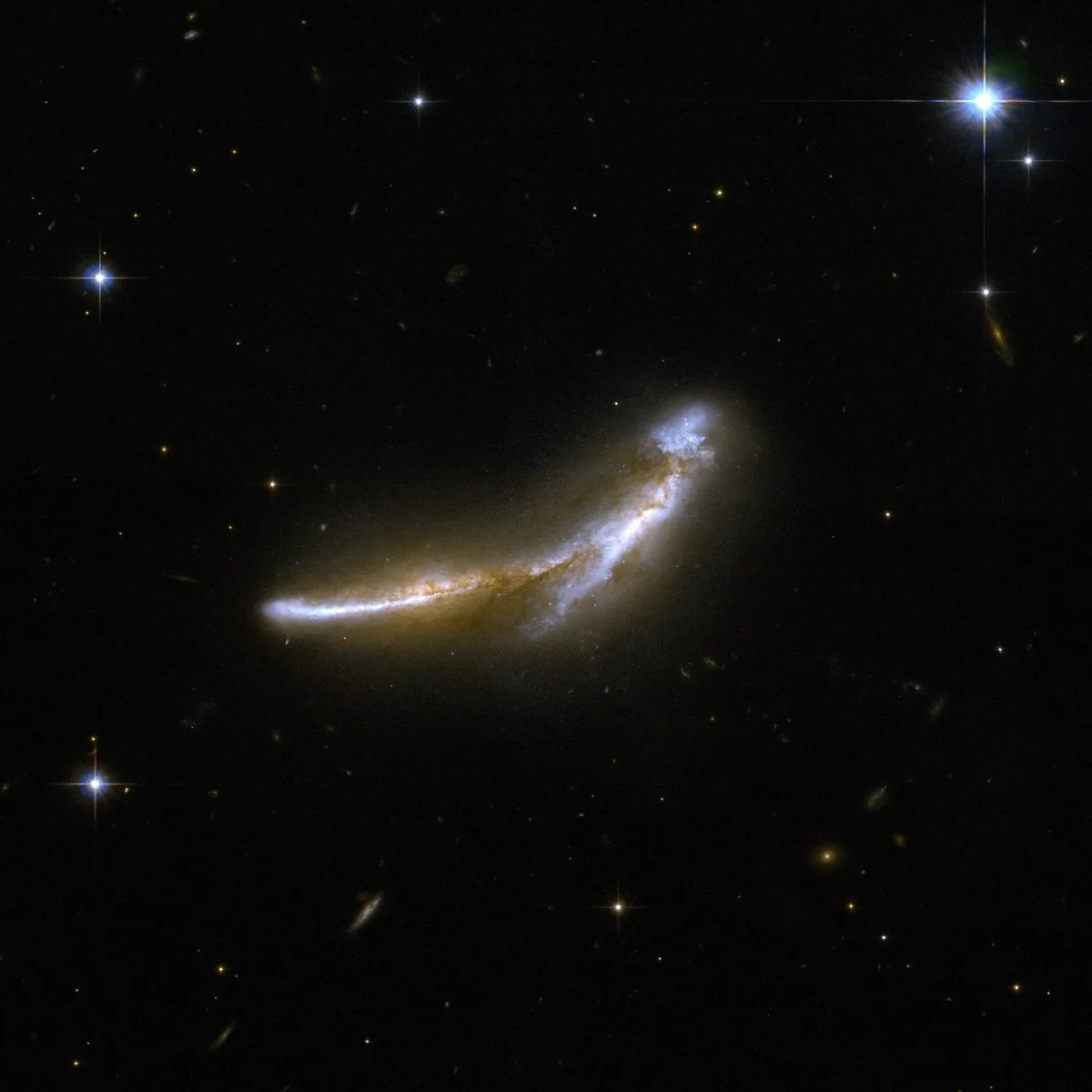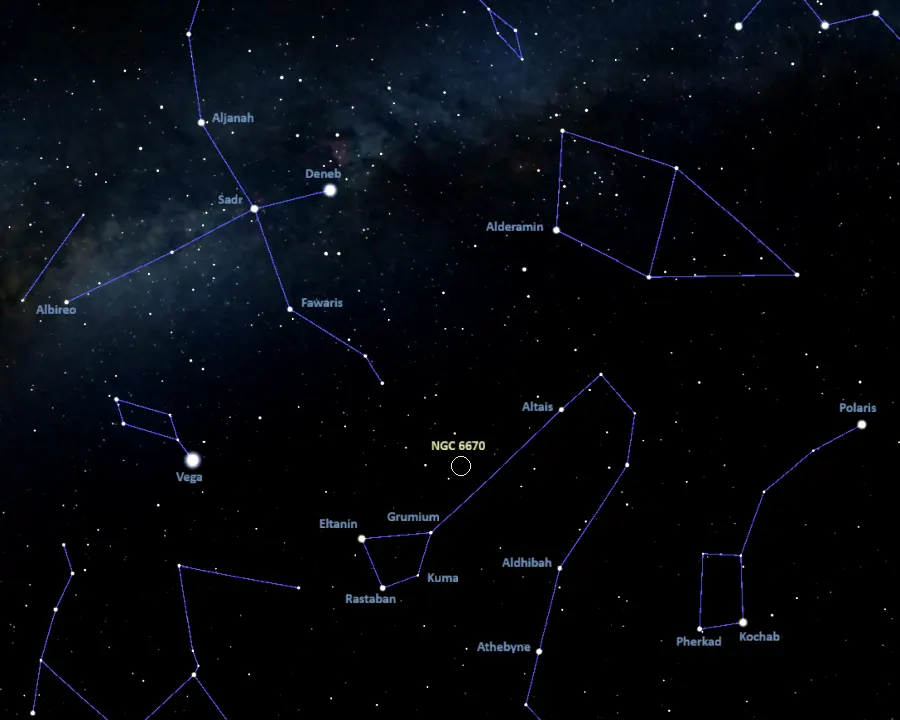The Dolphin Galaxy is a pair of colliding disk galaxies located approximately 401 million light years away in the northern constellation Draco. With an apparent magnitude of 14.3, the interacting galaxies are a challenging target for amateur telescopes. They are listed as NGC 6670 in the New General Catalogue.
The interacting galaxy pair was nicknamed the Dolphin Galaxy because its shape resembles that of a leaping dolphin. Both galaxies appear edge-on, and the galactic disks appear to touch each other in the plane of the sky. The two galactic nuclei are around 50,000 light-years (16 kpc) apart, corresponding to an angular separation of around 27 arcseconds.
NGC 6670 is classified as a luminous infrared galaxy (LIRG). It has an infrared luminosity of 3.8 x 1011 solar luminosities. LIRGs are defined as galaxies with luminosities above 1011 L☉. They are typically gas-rich galaxies whose excess infrared luminosity comes from an enhanced star formation rate or from an active galactic nucleus (AGN). Many of these objects are in fact merging spiral galaxies.

NGC 6670 is a gorgeous pair of overlapping edge-on galaxies resembling a leaping dolphin. Scientists believe that NGC 6670 has already experienced at least one close encounter and is now in the early stages of a second. The nuclei of the two galaxies are approximately 50,000 light-years apart. NGC 6670 glows in the infrared with more than a hundred billion times the luminosity of our Sun and is thought to be entering a starburst phase. The pair is located some 400 million light-years away from Earth. This image is part of a large collection of 59 images of merging galaxies taken by the Hubble Space Telescope and released on the occasion of its 18th anniversary on 24th April 2008. Image credit: NASA, ESA, the Hubble Heritage (STScI/AURA)-ESA/Hubble Collaboration, and A. Evans (University of Virginia, Charlottesville/NRAO/Stony Brook University) (PD)
The two colliding galaxies that form the Dolphin Galaxy are designated NGC 6670E and NGC 6670W. They are believed to have experienced at least one close encounter and are now approaching each other for the second.
NGC 6670E, the eastern of the two galaxies, has been severely disrupted by the collision with its neighbour. It lies in front of NGC 6670W. The galaxy has a bright core region that hosts massive star formation. The nuclear region of NGC 6670E produces at least four times as many new stars as the Milky Way’s disk.
NGC 6670W appears southwest of NGC 6670E. It is the larger of the two galaxies. Unlike its close neighbour, NGC 6670W does not show much evidence of galactic collision. It has a slightly warped disk, curved at the sides. The galaxy’s core appears fainter than that of NGC 6670E but nevertheless has a higher star formation rate than an average disk galaxy. It contains an H I region that appears as a rotating ring.
The Dolphin Galaxy has a luminosity of 100 billion Suns in the infrared band. As the interacting duo braces itself for a second close encounter, the cosmic Dolphin will enter a starburst phase. The gravitational forces and shock waves from the collision will trigger an exceptionally high rate of star formation, compressing vast amounts of dust and gas within a relatively short period of time. As a result, NGC 6670 will become even more luminous.
Facts
The Dolphin Galaxy was discovered by the American astronomer Lewis Swift on July 31, 1886.
In 1971, the Swiss astronomer Fritz Zwicky described the NGC 6670 system as a “post-eruptive quadruple system of three brush-like and one spherical compact” galaxies. The “brush-like” features were later linked with the galactic disks of NGC 6670E and NGC 6670W.
A 2001 study led by Wei-Hao Wang, Academia Sinica Institute of Astronomy and Astrophysics, Taipei, and Institute for Astronomy, University of Hawaii, Honolulu, identified an H I tail stretching around 293,500 light-years (90 kpc) west of the stellar disks of NGC 6670. The study was based on observations with the Very Large Array (VLA) and published in The Astronomical Journal in June 2001.
The detection of the tail provided evidence that the two late-type spiral galaxies have had at least one close encounter. The astronomers found that the galaxies are still in an early stage of interaction.
The team also detected a smaller H I tail that extends around 81,500 light years (25 kpc) in the northeast direction. Nether tidal tail has an optical stellar counterpart. The H I properties of the tails are similar to those found in the famous Antennae Galaxies (Arp 244) in the constellation Corvus and the Mice Galaxies (NGC 4676) in Coma Berenices.
The astronomers also found evidence of starburst in NGC 6670. Observations revealed large reservoirs of molecular gas and enhanced star formation activity in both galaxies’ central regions. Most of the H I in the galaxies forms a common halo around the two separate stellar disks of NGC 6670.
Location
The Dolphin Galaxy appears in the region of the celestial Dragon’s neck, close to the midpoint of the imaginary line connecting Eltanin (Gamma Draconis) and Altais (Delta Draconis).
Eltanin and Rastaban, the stars that mark the Dragon’s eyes, can be found by extending a line through the beam of the Northern Cross in Cygnus (the Swan). They form the Dragon’s head with the fainter Grumium (Xi Draconis) and Kuma (Nu Draconis). Altais is the brightest star appearing close to the line drawn from Rastaban through Grumium.
At declination +60°, the Dolphin Galaxy is best seen from the northern hemisphere. It never rises above the horizon for observers south of the latitude 30° S. The best time of the year to observe deep sky objects in Draco is during the month of July, when the constellation appears high above the horizon in the early evening.

Location of the Dolphin Galaxy (NGC 6670), image: Stellarium
Dolphin Galaxy – NGC 6670
| Constellation | Draco |
| Object type | Interacting galaxies |
| Morphological type | S |
| Right ascension | 18h 33m 35.45s |
| Declination | +59° 53′ 19.7″ |
| Apparent magnitude (V) | 14.3 |
| Apparent magnitude (B) | 15.1 |
| Apparent size | 1′ |
| Distance | 401 million light-years (123 megaparsecs) |
| Redshift | 8512 ± 101 km/s |
| Names and designations | Dolphin Galaxy, NGC 6670, LEDA 62033, PGC 62033, UGC 11284, IRAS 18329+5950, IRAS F18329+5950, NVSS J183335+595319, CGCG 301-31, CGPG 1832.9+5951, ZW VII 812, GB6 B1832+5951, ISOSS J18336+5953, ISOSS J18335+5953, PSCz Q18329+5950, WN B1832+5950, WN B1832.9+5950, Z 301-31, Z 1832.9+5951 |